外研版(2019)必修第三册Unit 6 Disaster and hope Using Language 教学设计
文档属性
| 名称 | 外研版(2019)必修第三册Unit 6 Disaster and hope Using Language 教学设计 | 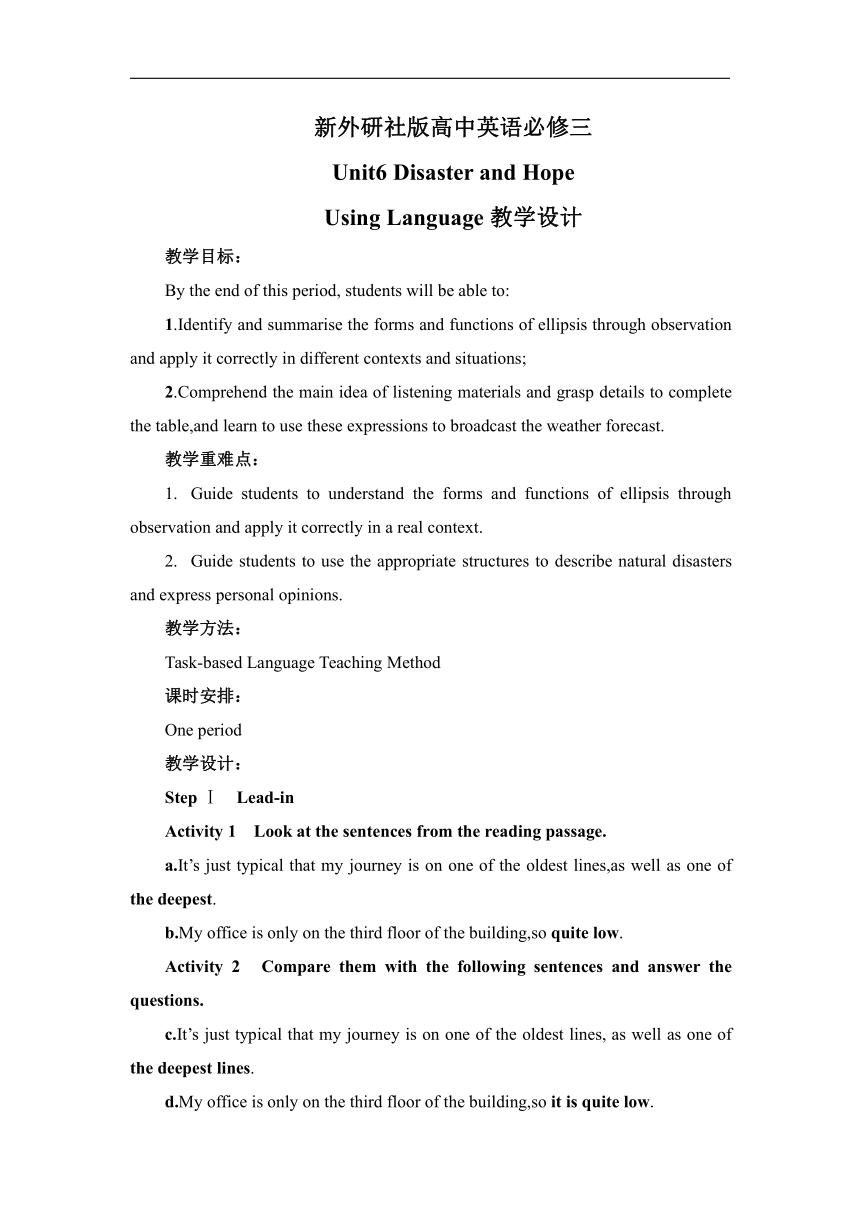 | |
| 格式 | docx | ||
| 文件大小 | 119.7KB | ||
| 资源类型 | 教案 | ||
| 版本资源 | 外研版(2019) | ||
| 科目 | 英语 | ||
| 更新时间 | 2024-03-06 12:19:53 | ||
图片预览

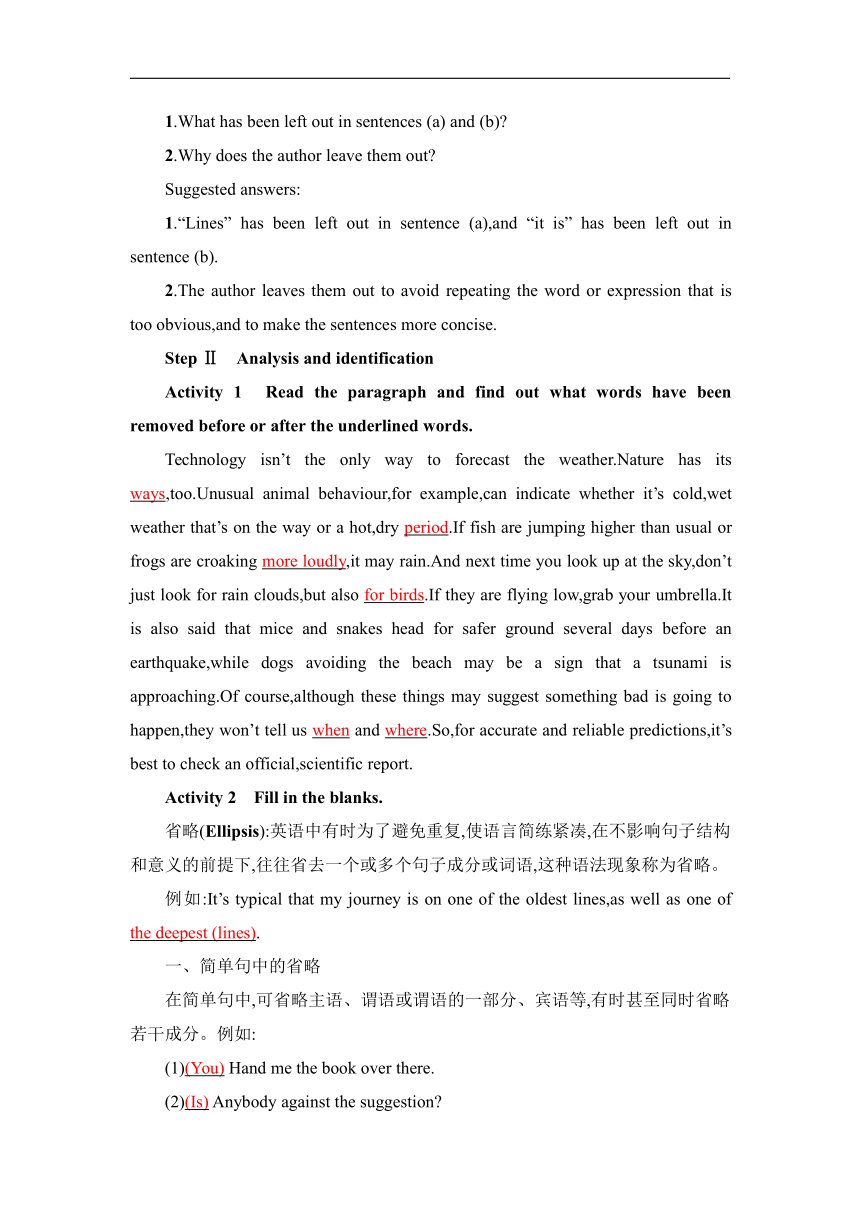
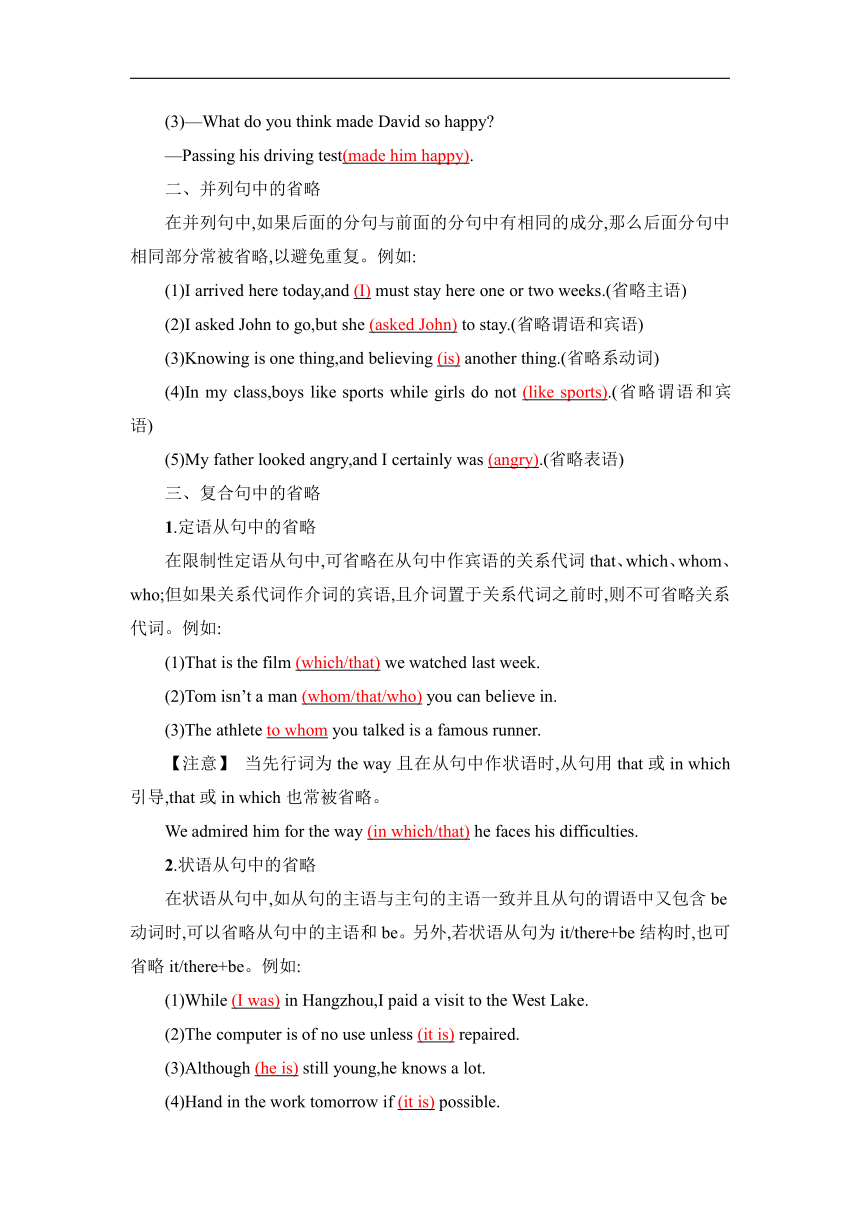
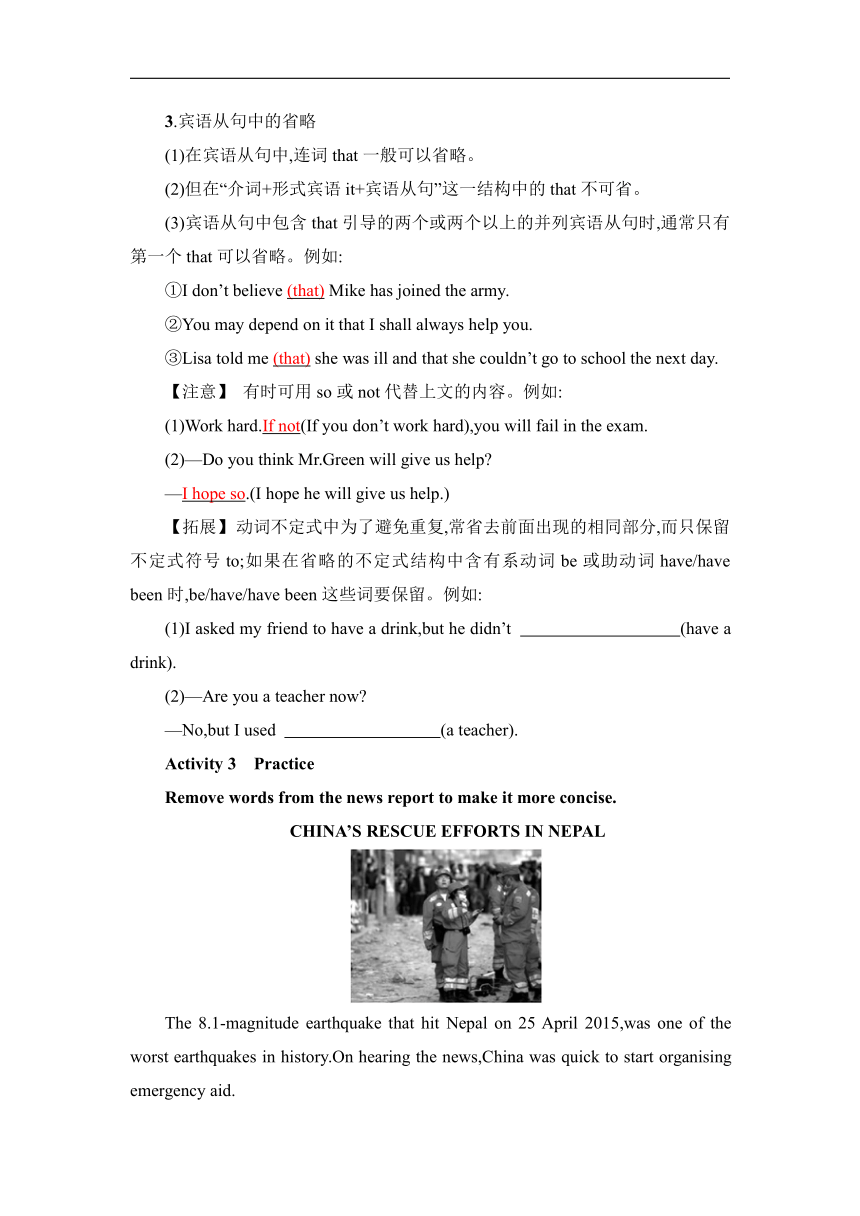
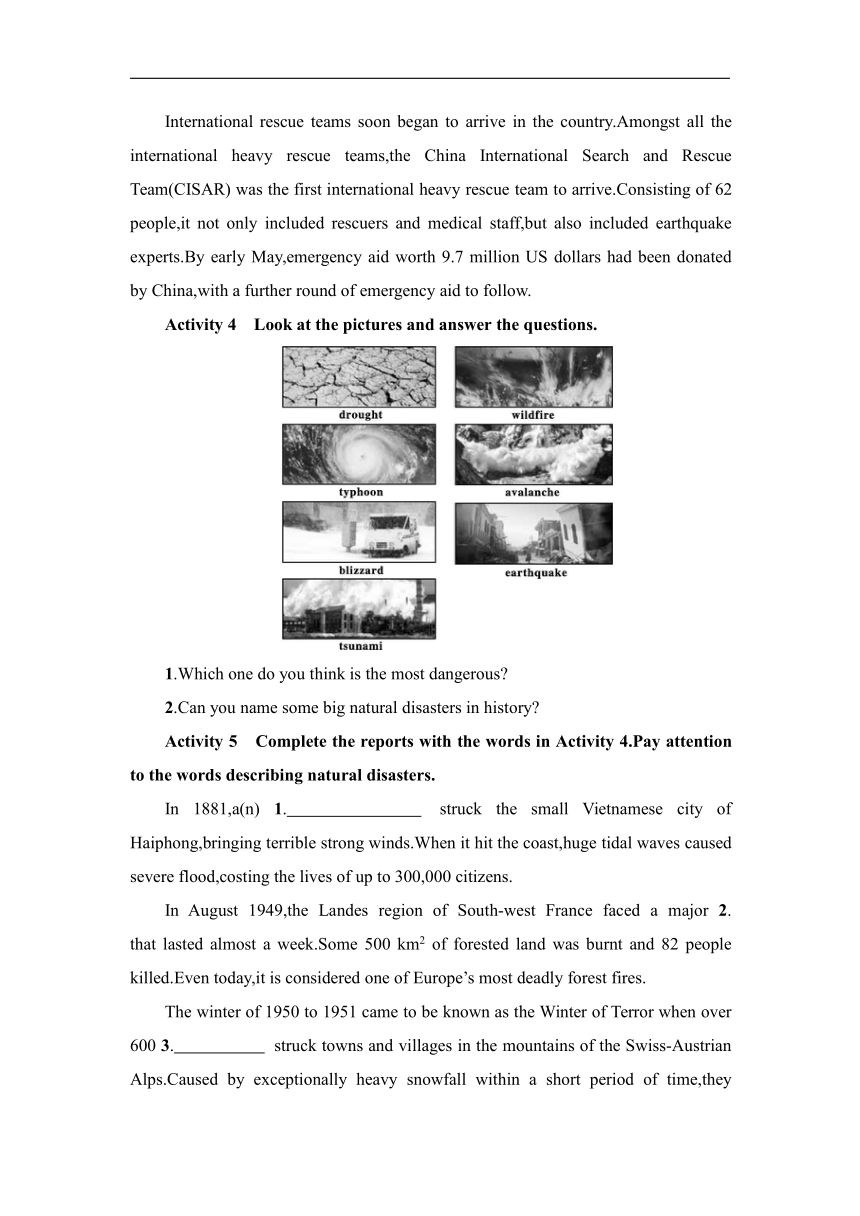
文档简介
新外研社版高中英语必修三
Unit6 Disaster and Hope
Using Language教学设计
教学目标:
By the end of this period, students will be able to:
1.Identify and summarise the forms and functions of ellipsis through observation and apply it correctly in different contexts and situations;
2.Comprehend the main idea of listening materials and grasp details to complete the table,and learn to use these expressions to broadcast the weather forecast.
教学重难点:
Guide students to understand the forms and functions of ellipsis through observation and apply it correctly in a real context.
Guide students to use the appropriate structures to describe natural disasters and express personal opinions.
教学方法:
Task-based Language Teaching Method
课时安排:
One period
教学设计:
Step Ⅰ Lead-in
Activity 1 Look at the sentences from the reading passage.
a.It’s just typical that my journey is on one of the oldest lines,as well as one of the deepest.
b.My office is only on the third floor of the building,so quite low.
Activity 2 Compare them with the following sentences and answer the questions.
c.It’s just typical that my journey is on one of the oldest lines, as well as one of the deepest lines.
d.My office is only on the third floor of the building,so it is quite low.
1.What has been left out in sentences (a) and (b)
2.Why does the author leave them out
Suggested answers:
1.“Lines” has been left out in sentence (a),and “it is” has been left out in sentence (b).
2.The author leaves them out to avoid repeating the word or expression that is too obvious,and to make the sentences more concise.
Step Ⅱ Analysis and identification
Activity 1 Read the paragraph and find out what words have been removed before or after the underlined words.
Technology isn’t the only way to forecast the weather.Nature has its ways,too.Unusual animal behaviour,for example,can indicate whether it’s cold,wet weather that’s on the way or a hot,dry period.If fish are jumping higher than usual or frogs are croaking more loudly,it may rain.And next time you look up at the sky,don’t just look for rain clouds,but also for birds.If they are flying low,grab your umbrella.It is also said that mice and snakes head for safer ground several days before an earthquake,while dogs avoiding the beach may be a sign that a tsunami is approaching.Of course,although these things may suggest something bad is going to happen,they won’t tell us when and where.So,for accurate and reliable predictions,it’s best to check an official,scientific report.
Activity 2 Fill in the blanks.
省略(Ellipsis):英语中有时为了避免重复,使语言简练紧凑,在不影响句子结构和意义的前提下,往往省去一个或多个句子成分或词语,这种语法现象称为省略。
例如:It’s typical that my journey is on one of the oldest lines,as well as one of the deepest (lines).
一、简单句中的省略
在简单句中,可省略主语、谓语或谓语的一部分、宾语等,有时甚至同时省略若干成分。例如:
(1)(You) Hand me the book over there.
(2)(Is) Anybody against the suggestion
(3)—What do you think made David so happy
—Passing his driving test(made him happy).
二、并列句中的省略
在并列句中,如果后面的分句与前面的分句中有相同的成分,那么后面分句中相同部分常被省略,以避免重复。例如:
(1)I arrived here today,and (I) must stay here one or two weeks.(省略主语)
(2)I asked John to go,but she (asked John) to stay.(省略谓语和宾语)
(3)Knowing is one thing,and believing (is) another thing.(省略系动词)
(4)In my class,boys like sports while girls do not (like sports).(省略谓语和宾语)
(5)My father looked angry,and I certainly was (angry).(省略表语)
三、复合句中的省略
1.定语从句中的省略
在限制性定语从句中,可省略在从句中作宾语的关系代词that、which、whom、who;但如果关系代词作介词的宾语,且介词置于关系代词之前时,则不可省略关系代词。例如:
(1)That is the film (which/that) we watched last week.
(2)Tom isn’t a man (whom/that/who) you can believe in.
(3)The athlete to whom you talked is a famous runner.
【注意】 当先行词为the way且在从句中作状语时,从句用that或in which引导,that或in which也常被省略。
We admired him for the way (in which/that) he faces his difficulties.
2.状语从句中的省略
在状语从句中,如从句的主语与主句的主语一致并且从句的谓语中又包含be动词时,可以省略从句中的主语和be。另外,若状语从句为it/there+be结构时,也可省略it/there+be。例如:
(1)While (I was) in Hangzhou,I paid a visit to the West Lake.
(2)The computer is of no use unless (it is) repaired.
(3)Although (he is) still young,he knows a lot.
(4)Hand in the work tomorrow if (it is) possible.
3.宾语从句中的省略
(1)在宾语从句中,连词that一般可以省略。
(2)但在“介词+形式宾语it+宾语从句”这一结构中的that不可省。
(3)宾语从句中包含that引导的两个或两个以上的并列宾语从句时,通常只有第一个that可以省略。例如:
①I don’t believe (that) Mike has joined the army.
②You may depend on it that I shall always help you.
③Lisa told me (that) she was ill and that she couldn’t go to school the next day.
【注意】 有时可用so或not代替上文的内容。例如:
(1)Work hard.If not(If you don’t work hard),you will fail in the exam.
(2)—Do you think Mr.Green will give us help
—I hope so.(I hope he will give us help.)
【拓展】 动词不定式中为了避免重复,常省去前面出现的相同部分,而只保留不定式符号to;如果在省略的不定式结构中含有系动词be或助动词have/have been时,be/have/have been这些词要保留。例如:
(1)I asked my friend to have a drink,but he didn’t (have a drink).
(2)—Are you a teacher now
—No,but I used (a teacher).
Activity 3 Practice
Remove words from the news report to make it more concise.
CHINA’S RESCUE EFFORTS IN NEPAL
The 8.1-magnitude earthquake that hit Nepal on 25 April 2015,was one of the worst earthquakes in history.On hearing the news,China was quick to start organising emergency aid.
International rescue teams soon began to arrive in the country.Amongst all the international heavy rescue teams,the China International Search and Rescue Team(CISAR) was the first international heavy rescue team to arrive.Consisting of 62 people,it not only included rescuers and medical staff,but also included earthquake experts.By early May,emergency aid worth 9.7 million US dollars had been donated by China,with a further round of emergency aid to follow.
Activity 4 Look at the pictures and answer the questions.
1.Which one do you think is the most dangerous
2.Can you name some big natural disasters in history
Activity 5 Complete the reports with the words in Activity 4.Pay attention to the words describing natural disasters.
In 1881,a(n) 1. struck the small Vietnamese city of Haiphong,bringing terrible strong winds.When it hit the coast,huge tidal waves caused severe flood,costing the lives of up to 300,000 citizens.
In August 1949,the Landes region of South-west France faced a major 2. that lasted almost a week.Some 500 km2 of forested land was burnt and 82 people killed.Even today,it is considered one of Europe’s most deadly forest fires.
The winter of 1950 to 1951 came to be known as the Winter of Terror when over 600 3. struck towns and villages in the mountains of the Swiss-Austrian Alps.Caused by exceptionally heavy snowfall within a short period of time,they destroyed buildings and forests,and claimed over 256 lives.
In 1960,Chile suffered the strongest 4. to be recorded in the 20th century.The shock is generally agreed to have had a magnitude of 9.5.It caused a(n) 5. with waves of up to 25 metres affecting places as far away as Hawaii and Japan.
A(n) 6. hit Iran in February 1972,causing a week of extremely low temperatures.Winter storms brought as much as 7.9 metres of snow in the south of the country, resulting in the deaths of about 4,000 people.
In July 2011,a(n) 7. struck East Africa. It was said to be the worst in 60 years,and not a single drop of rain fell for almost a whole year.It led to a severe food crisis and threatened the livelihoods of more than 9.5 million people.
Suggested answers:
Activity 1
Nature has its ways(to forecast the weather),too.
...whether it’s cold,wet weather that’s on the way or a hot,dry period(that’s on the way).
If fish are jumping higher than usual or frogs are croaking more loudly(than usual),it may rain.
...don’t just look for rain clouds,but also(look)for birds.
They won’t tell us when(something bad is going to happen)and where(something bad is going to happen).
Activity 2
(1)want to (2)to be
Activity 3
The 8.1-magnitude earthquake that hit Nepal on 25 April 2015,was one of the worst (earthquakes) in history.
Amongst all the international heavy rescue teams,the China International Search and Rescue Team(CISAR) was the first(international heavy rescue team) to arrive.
Consisting of 62 people,it not only included rescuers and medical staff,but also (included) earthquake experts.
By early May,emergency aid worth 9.7 million US dollars had been donated by China,with a further round(of emergency aid) to follow.
Activity 4
Students’ own answers.
Activity 5
1.typhoon 2.wildfire 3.avalanches 4.earthquake 5.tsunami 6.blizzard 7.drought
Step Ⅲ Listening
Activity 1 Extreme weather conditions
For thousands of years,people have been trying to predict the weather.In China during the Shang Dynasty,people recorded weather forecasts on animal bones and tortoise shells.Centuries later,in Greece,the philosopher,Aristotle wrote his theories about how weather conditions formed.Weather forecasting advanced over time,with more and more instruments to measure temperature,humidity and air pressure.Today,satellite data and computer technology help scientists predict the weather more precisely and comprehensively.
Activity 2 Listen again and complete the blog.
Anchorage You will need 1. . Temperatures will stay around 2. ℃.
Phoenix Temperatures are really high and it’s probably hot enough to 3. . Be sure to 4. if you or others have symptoms of heatstroke.
Houston It’s 5. season and there will be a big one across the Atlantic. Stay 6. and listen out for the latest forecasts.
Washington, DC Temperatures are going to stay around 7. ℃. Don’t drive 8. !
San Francisco Temperatures are going to be around 9.℃. People are suffering from 10. ,which are causing damage and loss.
Suggested answers:
Activity 1 略
Activity 2
1.warm clothes 2.-15 3.fry meat on the road 4.get medical attention 5.hurricane 6.safe indoors 7.13 8.through floodwaters 9.25 10.wildfires
听力评价量规
评价指标 优 良 中 差 自评 互评 师评
主旨要义 能够准确理解主旨要义,快速准确将气象符号与相关地点进行匹配 能够基本理解主旨要义,准确将气象符号与相关地点进行匹配 能够理解部分主旨要义,准确将气象符号与相关地点进行匹配 未能理解主旨要义,未能准确将气象符号与相关地点进行匹配
获取事实性的具体信息 能够准确获取听力材料细节信息(例如: 天气预报播报员是如何描述天气的) 能够基本获取听力材料细节信息 能够获取部分听力材料细节信息 未能获取听力材料细节信息
对所听内容做出推断 能够对所听内容做出准确推断 能够对所听内容做出基本推断 能够对所听部分内容做出推断 未能对所听内容做出推断
理解说话者的意图、观点 或态度 能够准确理解说话者的意图、观点或态度 能够基本理解说话者的意图、观点或态度 能够理解说话者的部分意图、观点或态度 未能理解说话者的意图、观点或态度
Step Ⅳ Discussion
Work in pairs.Act out the conversation to talk about an extreme weather condition.
Student A:Turn to Page 108.
Student B:Turn to Page 113.
Learning to learn
When listening to a weather forecast pay attention to the following information:
temperature levels
descriptions of forthcoming weather conditions
weather warnings
Step Ⅴ Homework
语法专练
1.Although (order) to stop,the driver kept on driving as fast as he could.
2.He succeeded in solving all the problems as (expect).
3.He had a wonderful childhood when (travel) with his mother to all corners of the world.
4.When (offer) an important role in a new movie,Andy got a chance to become famous.
5.Though (tire),they went on working in order to finish the task on time.
6.Some diseases are not all dangerous if (treat) in time.
7.What I want to do is (have) a good rest.
Suggested answers:
1.ordered 2.expected 3.travel(l)ing 4.offered 5.tired 6.treated 7.have
Step Ⅵ 语法评价量规
英语语法(省略)评价量表
评价指标 优 良 中 差 自评 互评 师评
基本概念 能准确理解和把握省略的用法 能基本理解和把握省略的用法 能部分理解和把握省略的用法 基本未能把握省略的用法
常见句型 能够非常准确地掌握简单句、并列句、复合句中的省略 能够基本上掌握简单句、并列句、复合句中的省略 能掌握部分简单句、并列句、复合句中的省略 基本上不知道简单句、并列句、复合句中的省略
应用 能够精准地识别文章和高考语法填空中的省略 能够在大部分情况下正确地识别文章和高考语法填空中的省略 在较少的情况下,能够正确地识别文章和高考语法填空中的省略 未能在文章和高考语法填空中识别省略
迁移 能够在作文中非常自如、恰当地使用省略 能够在作文中较为恰当地使用省略 能够在作文中使用省略,但是错误较多 基本上不会在作文中使用省略
教学反思
本板块包括语法部分Ellipsis、词汇部分 Types of natural disasters 和听说部分 Extreme weather conditions。语法部分的语段介绍了如何根据动物的行为来预测天气和自然灾害,以及中国国际救援队在尼泊尔地震后的救援工作,旨在引导学生感知发现、总结规律、在真实语境中了解和掌握省略句的特征和用法,并且了解中国在国际援助中所做的贡献;词汇部分通过图片呈现了与自然灾害有关的词汇,旨在引导学生掌握自然灾害相关的话题词汇,并运用这些词汇表达个人观点;听说部分的材料是一则天气预报,旨在引导学生理解播报内容和相关知识。整个板块为学生提供真实语境下的英语综合技能训练,以帮助学生在提高语言应用能力的同时加深其对单元主题的理解。
Unit6 Disaster and Hope
Using Language教学设计
教学目标:
By the end of this period, students will be able to:
1.Identify and summarise the forms and functions of ellipsis through observation and apply it correctly in different contexts and situations;
2.Comprehend the main idea of listening materials and grasp details to complete the table,and learn to use these expressions to broadcast the weather forecast.
教学重难点:
Guide students to understand the forms and functions of ellipsis through observation and apply it correctly in a real context.
Guide students to use the appropriate structures to describe natural disasters and express personal opinions.
教学方法:
Task-based Language Teaching Method
课时安排:
One period
教学设计:
Step Ⅰ Lead-in
Activity 1 Look at the sentences from the reading passage.
a.It’s just typical that my journey is on one of the oldest lines,as well as one of the deepest.
b.My office is only on the third floor of the building,so quite low.
Activity 2 Compare them with the following sentences and answer the questions.
c.It’s just typical that my journey is on one of the oldest lines, as well as one of the deepest lines.
d.My office is only on the third floor of the building,so it is quite low.
1.What has been left out in sentences (a) and (b)
2.Why does the author leave them out
Suggested answers:
1.“Lines” has been left out in sentence (a),and “it is” has been left out in sentence (b).
2.The author leaves them out to avoid repeating the word or expression that is too obvious,and to make the sentences more concise.
Step Ⅱ Analysis and identification
Activity 1 Read the paragraph and find out what words have been removed before or after the underlined words.
Technology isn’t the only way to forecast the weather.Nature has its ways,too.Unusual animal behaviour,for example,can indicate whether it’s cold,wet weather that’s on the way or a hot,dry period.If fish are jumping higher than usual or frogs are croaking more loudly,it may rain.And next time you look up at the sky,don’t just look for rain clouds,but also for birds.If they are flying low,grab your umbrella.It is also said that mice and snakes head for safer ground several days before an earthquake,while dogs avoiding the beach may be a sign that a tsunami is approaching.Of course,although these things may suggest something bad is going to happen,they won’t tell us when and where.So,for accurate and reliable predictions,it’s best to check an official,scientific report.
Activity 2 Fill in the blanks.
省略(Ellipsis):英语中有时为了避免重复,使语言简练紧凑,在不影响句子结构和意义的前提下,往往省去一个或多个句子成分或词语,这种语法现象称为省略。
例如:It’s typical that my journey is on one of the oldest lines,as well as one of the deepest (lines).
一、简单句中的省略
在简单句中,可省略主语、谓语或谓语的一部分、宾语等,有时甚至同时省略若干成分。例如:
(1)(You) Hand me the book over there.
(2)(Is) Anybody against the suggestion
(3)—What do you think made David so happy
—Passing his driving test(made him happy).
二、并列句中的省略
在并列句中,如果后面的分句与前面的分句中有相同的成分,那么后面分句中相同部分常被省略,以避免重复。例如:
(1)I arrived here today,and (I) must stay here one or two weeks.(省略主语)
(2)I asked John to go,but she (asked John) to stay.(省略谓语和宾语)
(3)Knowing is one thing,and believing (is) another thing.(省略系动词)
(4)In my class,boys like sports while girls do not (like sports).(省略谓语和宾语)
(5)My father looked angry,and I certainly was (angry).(省略表语)
三、复合句中的省略
1.定语从句中的省略
在限制性定语从句中,可省略在从句中作宾语的关系代词that、which、whom、who;但如果关系代词作介词的宾语,且介词置于关系代词之前时,则不可省略关系代词。例如:
(1)That is the film (which/that) we watched last week.
(2)Tom isn’t a man (whom/that/who) you can believe in.
(3)The athlete to whom you talked is a famous runner.
【注意】 当先行词为the way且在从句中作状语时,从句用that或in which引导,that或in which也常被省略。
We admired him for the way (in which/that) he faces his difficulties.
2.状语从句中的省略
在状语从句中,如从句的主语与主句的主语一致并且从句的谓语中又包含be动词时,可以省略从句中的主语和be。另外,若状语从句为it/there+be结构时,也可省略it/there+be。例如:
(1)While (I was) in Hangzhou,I paid a visit to the West Lake.
(2)The computer is of no use unless (it is) repaired.
(3)Although (he is) still young,he knows a lot.
(4)Hand in the work tomorrow if (it is) possible.
3.宾语从句中的省略
(1)在宾语从句中,连词that一般可以省略。
(2)但在“介词+形式宾语it+宾语从句”这一结构中的that不可省。
(3)宾语从句中包含that引导的两个或两个以上的并列宾语从句时,通常只有第一个that可以省略。例如:
①I don’t believe (that) Mike has joined the army.
②You may depend on it that I shall always help you.
③Lisa told me (that) she was ill and that she couldn’t go to school the next day.
【注意】 有时可用so或not代替上文的内容。例如:
(1)Work hard.If not(If you don’t work hard),you will fail in the exam.
(2)—Do you think Mr.Green will give us help
—I hope so.(I hope he will give us help.)
【拓展】 动词不定式中为了避免重复,常省去前面出现的相同部分,而只保留不定式符号to;如果在省略的不定式结构中含有系动词be或助动词have/have been时,be/have/have been这些词要保留。例如:
(1)I asked my friend to have a drink,but he didn’t (have a drink).
(2)—Are you a teacher now
—No,but I used (a teacher).
Activity 3 Practice
Remove words from the news report to make it more concise.
CHINA’S RESCUE EFFORTS IN NEPAL
The 8.1-magnitude earthquake that hit Nepal on 25 April 2015,was one of the worst earthquakes in history.On hearing the news,China was quick to start organising emergency aid.
International rescue teams soon began to arrive in the country.Amongst all the international heavy rescue teams,the China International Search and Rescue Team(CISAR) was the first international heavy rescue team to arrive.Consisting of 62 people,it not only included rescuers and medical staff,but also included earthquake experts.By early May,emergency aid worth 9.7 million US dollars had been donated by China,with a further round of emergency aid to follow.
Activity 4 Look at the pictures and answer the questions.
1.Which one do you think is the most dangerous
2.Can you name some big natural disasters in history
Activity 5 Complete the reports with the words in Activity 4.Pay attention to the words describing natural disasters.
In 1881,a(n) 1. struck the small Vietnamese city of Haiphong,bringing terrible strong winds.When it hit the coast,huge tidal waves caused severe flood,costing the lives of up to 300,000 citizens.
In August 1949,the Landes region of South-west France faced a major 2. that lasted almost a week.Some 500 km2 of forested land was burnt and 82 people killed.Even today,it is considered one of Europe’s most deadly forest fires.
The winter of 1950 to 1951 came to be known as the Winter of Terror when over 600 3. struck towns and villages in the mountains of the Swiss-Austrian Alps.Caused by exceptionally heavy snowfall within a short period of time,they destroyed buildings and forests,and claimed over 256 lives.
In 1960,Chile suffered the strongest 4. to be recorded in the 20th century.The shock is generally agreed to have had a magnitude of 9.5.It caused a(n) 5. with waves of up to 25 metres affecting places as far away as Hawaii and Japan.
A(n) 6. hit Iran in February 1972,causing a week of extremely low temperatures.Winter storms brought as much as 7.9 metres of snow in the south of the country, resulting in the deaths of about 4,000 people.
In July 2011,a(n) 7. struck East Africa. It was said to be the worst in 60 years,and not a single drop of rain fell for almost a whole year.It led to a severe food crisis and threatened the livelihoods of more than 9.5 million people.
Suggested answers:
Activity 1
Nature has its ways(to forecast the weather),too.
...whether it’s cold,wet weather that’s on the way or a hot,dry period(that’s on the way).
If fish are jumping higher than usual or frogs are croaking more loudly(than usual),it may rain.
...don’t just look for rain clouds,but also(look)for birds.
They won’t tell us when(something bad is going to happen)and where(something bad is going to happen).
Activity 2
(1)want to (2)to be
Activity 3
The 8.1-magnitude earthquake that hit Nepal on 25 April 2015,was one of the worst (earthquakes) in history.
Amongst all the international heavy rescue teams,the China International Search and Rescue Team(CISAR) was the first(international heavy rescue team) to arrive.
Consisting of 62 people,it not only included rescuers and medical staff,but also (included) earthquake experts.
By early May,emergency aid worth 9.7 million US dollars had been donated by China,with a further round(of emergency aid) to follow.
Activity 4
Students’ own answers.
Activity 5
1.typhoon 2.wildfire 3.avalanches 4.earthquake 5.tsunami 6.blizzard 7.drought
Step Ⅲ Listening
Activity 1 Extreme weather conditions
For thousands of years,people have been trying to predict the weather.In China during the Shang Dynasty,people recorded weather forecasts on animal bones and tortoise shells.Centuries later,in Greece,the philosopher,Aristotle wrote his theories about how weather conditions formed.Weather forecasting advanced over time,with more and more instruments to measure temperature,humidity and air pressure.Today,satellite data and computer technology help scientists predict the weather more precisely and comprehensively.
Activity 2 Listen again and complete the blog.
Anchorage You will need 1. . Temperatures will stay around 2. ℃.
Phoenix Temperatures are really high and it’s probably hot enough to 3. . Be sure to 4. if you or others have symptoms of heatstroke.
Houston It’s 5. season and there will be a big one across the Atlantic. Stay 6. and listen out for the latest forecasts.
Washington, DC Temperatures are going to stay around 7. ℃. Don’t drive 8. !
San Francisco Temperatures are going to be around 9.℃. People are suffering from 10. ,which are causing damage and loss.
Suggested answers:
Activity 1 略
Activity 2
1.warm clothes 2.-15 3.fry meat on the road 4.get medical attention 5.hurricane 6.safe indoors 7.13 8.through floodwaters 9.25 10.wildfires
听力评价量规
评价指标 优 良 中 差 自评 互评 师评
主旨要义 能够准确理解主旨要义,快速准确将气象符号与相关地点进行匹配 能够基本理解主旨要义,准确将气象符号与相关地点进行匹配 能够理解部分主旨要义,准确将气象符号与相关地点进行匹配 未能理解主旨要义,未能准确将气象符号与相关地点进行匹配
获取事实性的具体信息 能够准确获取听力材料细节信息(例如: 天气预报播报员是如何描述天气的) 能够基本获取听力材料细节信息 能够获取部分听力材料细节信息 未能获取听力材料细节信息
对所听内容做出推断 能够对所听内容做出准确推断 能够对所听内容做出基本推断 能够对所听部分内容做出推断 未能对所听内容做出推断
理解说话者的意图、观点 或态度 能够准确理解说话者的意图、观点或态度 能够基本理解说话者的意图、观点或态度 能够理解说话者的部分意图、观点或态度 未能理解说话者的意图、观点或态度
Step Ⅳ Discussion
Work in pairs.Act out the conversation to talk about an extreme weather condition.
Student A:Turn to Page 108.
Student B:Turn to Page 113.
Learning to learn
When listening to a weather forecast pay attention to the following information:
temperature levels
descriptions of forthcoming weather conditions
weather warnings
Step Ⅴ Homework
语法专练
1.Although (order) to stop,the driver kept on driving as fast as he could.
2.He succeeded in solving all the problems as (expect).
3.He had a wonderful childhood when (travel) with his mother to all corners of the world.
4.When (offer) an important role in a new movie,Andy got a chance to become famous.
5.Though (tire),they went on working in order to finish the task on time.
6.Some diseases are not all dangerous if (treat) in time.
7.What I want to do is (have) a good rest.
Suggested answers:
1.ordered 2.expected 3.travel(l)ing 4.offered 5.tired 6.treated 7.have
Step Ⅵ 语法评价量规
英语语法(省略)评价量表
评价指标 优 良 中 差 自评 互评 师评
基本概念 能准确理解和把握省略的用法 能基本理解和把握省略的用法 能部分理解和把握省略的用法 基本未能把握省略的用法
常见句型 能够非常准确地掌握简单句、并列句、复合句中的省略 能够基本上掌握简单句、并列句、复合句中的省略 能掌握部分简单句、并列句、复合句中的省略 基本上不知道简单句、并列句、复合句中的省略
应用 能够精准地识别文章和高考语法填空中的省略 能够在大部分情况下正确地识别文章和高考语法填空中的省略 在较少的情况下,能够正确地识别文章和高考语法填空中的省略 未能在文章和高考语法填空中识别省略
迁移 能够在作文中非常自如、恰当地使用省略 能够在作文中较为恰当地使用省略 能够在作文中使用省略,但是错误较多 基本上不会在作文中使用省略
教学反思
本板块包括语法部分Ellipsis、词汇部分 Types of natural disasters 和听说部分 Extreme weather conditions。语法部分的语段介绍了如何根据动物的行为来预测天气和自然灾害,以及中国国际救援队在尼泊尔地震后的救援工作,旨在引导学生感知发现、总结规律、在真实语境中了解和掌握省略句的特征和用法,并且了解中国在国际援助中所做的贡献;词汇部分通过图片呈现了与自然灾害有关的词汇,旨在引导学生掌握自然灾害相关的话题词汇,并运用这些词汇表达个人观点;听说部分的材料是一则天气预报,旨在引导学生理解播报内容和相关知识。整个板块为学生提供真实语境下的英语综合技能训练,以帮助学生在提高语言应用能力的同时加深其对单元主题的理解。
